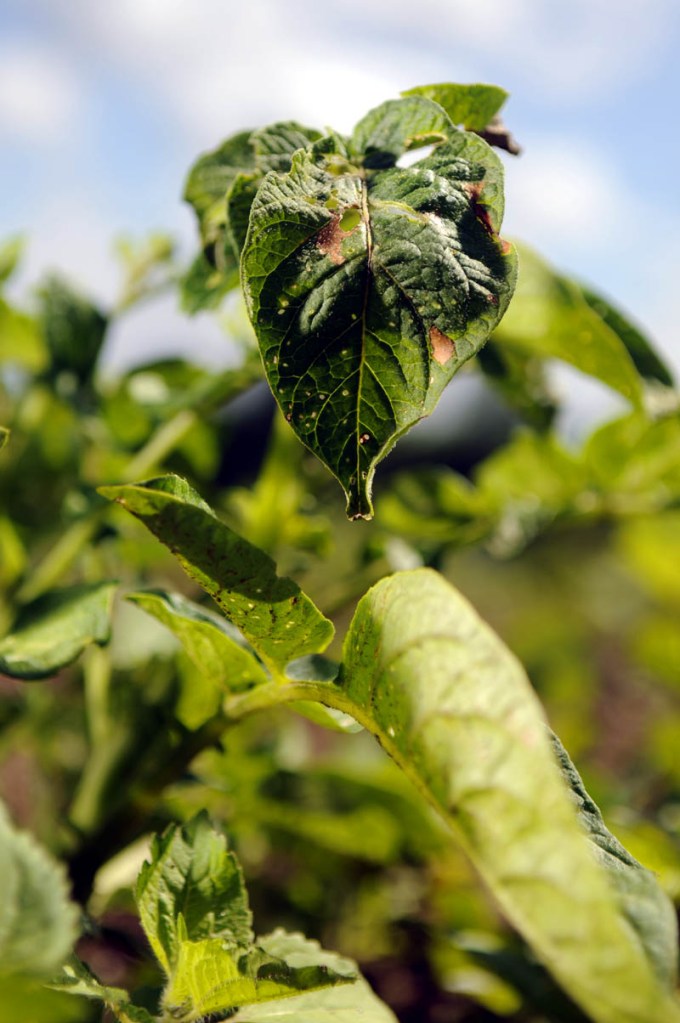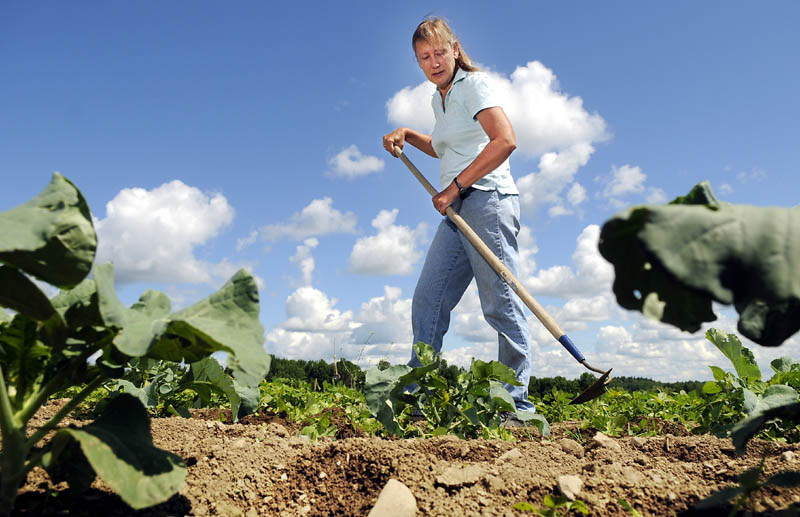SIDNEY — Diane Campbell never uses chemical fertilizer, but out of desperation, she sprinkled some on her pepper plants.
Campbell, who runs Wolf Creek Farm in Sidney with her husband, Robert, said the recent hot, dry weather, followed by days of heavy rain, is taking its toll on crops.
It started in March with temperatures that soared into the 70s and 80s, dipped to freezing levels in April, followed by heavy rain in May and June.
The National Weather Service in Gray recorded 11.03 inches of rain in June, almost 7 inches above average.
At Wolf Creek Farm, Campbell’s pepper plants are only 3 inches tall. Many of them have peppers, but they’re only an inch or two long.
“To have a pepper be this size — look at this,” she said, bending down next to the tiny green plant. “I have basil and squash that are yellow.”
She pointed down a long, neat row. “And all those weeds, that’s where my potatoes are supposed to be. And I doubt the season will be long enough for pumpkins. They take 90 days to ripe.”
Campbell sells her vegetables at a farm stand across the road from her 350-acre farm on a hill off Middle Road.
She’s had to plant her neat rows of beans three times. The weather caused them to rot, along with a quarter of her potato crop.
By now she would have Swiss chard and beet greens to sell at the stand. Cucumbers normally would follow in about two weeks.
But not this year.
After four-day stretch of rain last week, the leaves on her squash and cucumber plants turned yellow.
“I have to admit it’s pretty poor this year,” she said. “The weeds are growing great, but not the vegetable plants.”
Her husband has had some setbacks with haying. He had planned to cut hay June 27, but because of reported thunderstorms, that got put off until the next day.
Instead of putting up dry bales of hay for his beef cattle, he did what is called a silage wrap, in which the green hay is bundled in plastic. Those bales of hay look like huge marshmallows lying in the fields.
“It ferments and you get a better quality feed for the beef cattle; there’s more protein,” he said.
Late in the season
Kevin Leavitt, owner of Farmer Kev’s Organic Produce in Winthrop, said his tomatoes and peppers are not doing well. He said the soil becomes soggy and so compact that air can’t pass through it.
As a result, the plants are unable to draw in nutrients.
“We didn’t have any fields flood, but seed got pushed out from the hard rains, and a lot of the seed rotted. It was too cold and damp,” Leavitt said. “In our situation, we replanted. Most people will. That’s all you can do unless you run out of something like tomatoes because they happened to die.”
Russell Libby, executive director of the Maine Organic Farmers and Gardeners Association, said some farmers who were late with seed may decide to forgo planting altogether because it’s too late in the season.
“The exciting thing is many of the farmers are using greenhouses. We’re seeing a lot of crops coming out of hoop houses even with bad weather,” Libby said. “They’re bringing good stuff to the farmers’ markets even when they have to deal with rain outside their hoop houses.”
A hoop house is a greenhouse with a plastic roof wrapped over flexible piping.
Jim Dill, pest management specialist at the University of Maine Cooperative Extension, said Maine won’t see a shortage of hay this year. Some farmers have managed to beat the wet weather and already had one cutting of hay.
“The last week and a half of rain just helped it grow, so they’ll get a second, maybe even a third cutting,” Dill said.
He said crops will be a week or two later than usual. Farmers whose crops were put in may get a better price because the competition is still waiting for their plants. That will change once they have produce to sell.
Dill said diseased plants could become an issue later in the season because of humid weather.
‘Put up with the weather or quit’
Tom Stevenson grows vegetables on 30 acres in Wayne for two family farmstands — on U.S. Route 202 in Winthrop and on Route 219 in Leeds. He said his crops are struggling.
“The hot, hot weather is just adding extra stress to an already stressed-out plant,” Stevenson said. “Hopefully, the later part of the summer is better than the early part of the summer.”
He said things need to dry out and the weather must become more consistent. He’s hoping for 60-degree temperatures at night and 80 degrees during the day.
His father, Ford Stevenson, is a strawberry grower in Wayne.
He said the strawberry season is winding down early — Tuesday was the last day on which people could pick their own. Strawberries are usually ready for picking by the end of June, with the season lasting about three weeks.
“When you wake up in March and it’s 80 degrees, you know you’re going to have a challenge,” Stevenson said. “Strawberries are a perennial. They got an early start and were going good. Then in April we got very cold, hard freezes. The last weekend in May was OK, but then there was all that rain.”
Eric Elvin, 67, of Readfield, who has been farming for about four decades, said the weather has been “a little wet” so far, but felt Mainers were much better off than the rest of the country between of raging fires out West and flooding elsewhere.
“I think we’re pretty lucky,” Elvin said. “We’ve just had a little mud. You have to adjust to the weather. You either have to plant early or late. We did both to get by … to get around the weather.”
He said there have been plenty of other years when things didn’t go right.
“It’s part of it all,” he said. “You either put up with the weather or quit.”
Mechele Cooper — 621-5663
mcooper@centralmaine.com
Send questions/comments to the editors.




Success. Please wait for the page to reload. If the page does not reload within 5 seconds, please refresh the page.
Enter your email and password to access comments.
Hi, to comment on stories you must . This profile is in addition to your subscription and website login.
Already have a commenting profile? .
Invalid username/password.
Please check your email to confirm and complete your registration.
Only subscribers are eligible to post comments. Please subscribe or login first for digital access. Here’s why.
Use the form below to reset your password. When you've submitted your account email, we will send an email with a reset code.